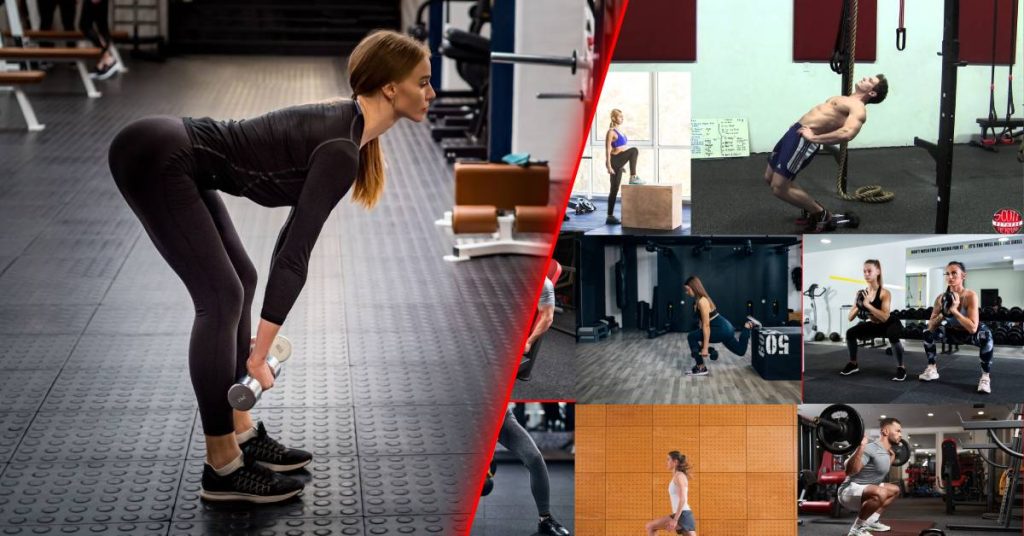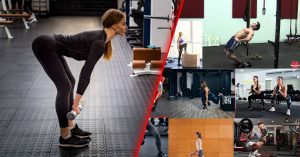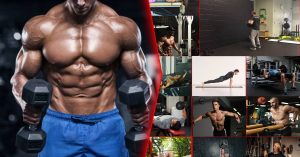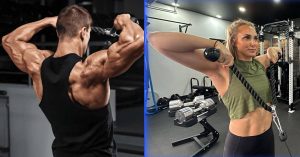You may be searching over the internet what are the Top lower body push exercises to improve your strength in the lower body and overall fitness. If that’s the case, you don’t need to look further elsewhere. It’s because we have covered all available best exercise options that can help you achieve your goal with this article.
Let’s get started…
Table of contents
MORE keyboard_double_arrow_down LESS keyboard_double_arrow_up
What are Lower Body Push Exercises?
Lower body push exercises are a category of strength-training exercises that target the muscles of the lower body, primarily emphasizing movements where force is exerted away from the body using the legs and feet.
These exercises typically involve extending or pushing your legs against resistance in various forms, such as body weight, free weights, machines, or resistance bands. The main muscle groups targeted in lower body push exercises include the quadriceps, hamstrings, glutes, and calves.
Key characteristics of lower body push exercises include:
- Muscle Engagement: Lower body push exercises engage large muscle groups in the legs and hips, including the quadriceps (front of the thighs), hamstrings (back of the thighs), gluteal muscles (buttocks), and calf muscles.
- Pushing Motion: These exercises involve movements where the legs are extended or pushed against resistance, often in a vertical or horizontal direction away from the body.
- Functional Movement Patterns: Many lower body push exercises mimic everyday movements like walking, running, climbing stairs, or rising from a seated position, making them beneficial for improving functional fitness and mobility.
- Compound Movements: Lower body push exercises often involve compound movements, which means they engage multiple muscle groups and joints simultaneously, leading to more efficient workouts and greater calorie expenditure.
What are the benefits of including Lower Body Push Exercises in your daily workout?
Lower body push exercises are pivotal components of any fitness routine, offering a range of benefits that contribute to overall physical health and well-being. By targeting major muscle groups in the lower body and emphasizing functional movement patterns, these exercises play a crucial role in building strength, enhancing stability, and improving athletic performance.
Here is a quick summary that shows the significance of lower body push exercises and their impact on achieving optimal fitness goals.
- Strength and Muscle Development: Lower body push exercises target major muscle groups such as the quadriceps, hamstrings, glutes, and calves. By regularly engaging these muscles through resistance training, individuals can improve strength, power, and muscle definition in the lower body.
- Functional Movement Patterns: Many lower body push exercises mimic everyday movements like walking, running, climbing stairs, and standing up from a seated position. By training these movement patterns with resistance, individuals can improve their ability to perform daily activities with greater ease and efficiency.
- Balance and Stability: Lower body push exercises often require stabilization from the core and upper body muscles, in addition to the lower body. This helps improve overall balance, stability, and coordination, which are important for reducing the risk of falls and injuries, especially as individuals age.
- Metabolic Benefits: Since lower body push exercises engage large muscle groups, they can elicit a significant metabolic response, leading to increased calorie burning both during and after exercise. This can be beneficial for weight management, fat loss, and overall metabolic health.
- Joint Health and Injury Prevention: Proper execution of lower body push exercises can help improve joint stability, flexibility, and mobility. Strengthening the muscles around the knees, hips, and ankles can reduce the risk of common injuries, such as strains, sprains, and ligament tears.
- Improved Athletic Performance: Strong and powerful lower body muscles are essential for athletic performance in various sports and activities. Lower body push exercises can enhance abilities such as jumping, sprinting, kicking, and change of direction, making individuals more proficient and competitive in their chosen activities.
- Enhanced Quality of Life: By improving lower body strength, mobility, and overall fitness, lower body push exercises can enhance quality of life and promote independence as individuals age. They enable individuals to maintain an active lifestyle, participate in recreational activities, and enjoy a higher level of physical function and well-being.
Ok, now you may be wondering what are the top Lower body push exercises that can be included in your workout routine. No need to worry. Here are our top 15 picks for you.
Top 15 Lower Body Push Exercises
The top lower body push exercises encompass a variety of movements that effectively target the major muscle groups in the legs and hips while promoting strength, stability, and functional movement patterns.
Here are our top 15 most effective lower body push exercises list.
1. Squat:
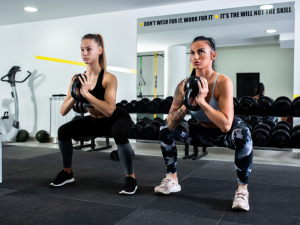
The squat is a fundamental lower body exercise targeting the quadriceps, hamstrings, glutes, and core. Its versatility allows for various modifications to cater to different fitness levels and goals.
How To Do Squat?
- Stand with feet slightly wider than shoulder-width apart, toes pointing slightly outward.
- Engage core muscles and keep chest up.
- Lower body by bending knees and hips, keeping weight on heels.
- Descend until thighs are parallel to the ground or slightly below.
- Press through heels to return to standing position, squeezing glutes at the top.
- Repeat
Execution Tips Enhanced:
- Maintain a neutral spine throughout the movement.
- Ensure knees track in line with toes.
- Keep weight evenly distributed on both feet.
Why It Works Explained:
The squat is effective due to its ability to target multiple lower body muscle groups simultaneously. It promotes strength, power, and muscle growth while improving functional movement patterns.
Additionally, engaging the core and maintaining proper form enhance stability and reduce injury risk.
2. Bulgarian Split Squats:
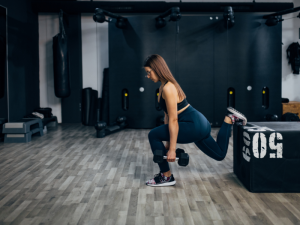
Bulgarian split squats are unilateral exercises that challenge balance and stability while targeting the quadriceps, hamstrings, and glutes. They offer a unique variation to traditional squats, allowing for focused muscle engagement in each leg.
How To Do Bulgarian Split Squats?
- Stand facing away from a bench or elevated platform.
- Place one foot on the bench behind you, laces down.
- Keep the other foot flat on the ground, a few feet in front of the bench.
- Lower your body by bending the front knee until the thigh is parallel to the ground.
- Press through the heel to return to the starting position.
- Repeat.
Execution Tips Enhanced:
- Keep the torso upright throughout the movement.
- Lower the back knee towards the ground with control.
- Ensure front knee does not extend beyond toes.
Why It Works Explained:
Bulgarian split squats isolate each leg independently, helping to correct muscle imbalances and improve unilateral strength. The exercise challenges stability and coordination while providing a deep stretch in the hip flexors and targeting the quadriceps and glutes effectively.
3. Lunges:
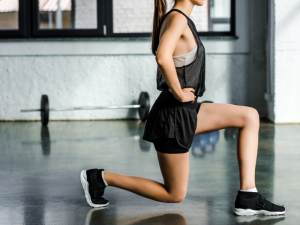
Lunges are versatile lower body exercises that engage multiple muscle groups, including the quadriceps, hamstrings, glutes, and calves. They can be performed in various directions and with different equipment to target specific areas of the lower body.
How To Do Lunges?
- Stand tall with feet hip-width apart.
- Take a step forward or backward with one leg, keeping the torso upright.
- Lower the body until both knees are bent at a 90-degree angle, with the back knee hovering just above the ground.
- Press through the heel of the front foot to return to the starting position.
- Repeat on the other leg.
Execution Tips Enhanced:
- Keep the front knee aligned with the ankle, not extending past the toes.
- Maintain a straight back and engage the core for stability.
- Control the descent and ascent to maximize muscle engagement.
Why It Works Explained:
Lunges are effective for building lower body strength, improving balance, and enhancing functional movement patterns. They target multiple muscle groups simultaneously, promoting muscle symmetry and coordination. Lunges also offer versatility, allowing for variations such as reverse lunges, walking lunges, and lateral lunges to target different muscle groups and movement patterns.
4. Reverse Lunge:
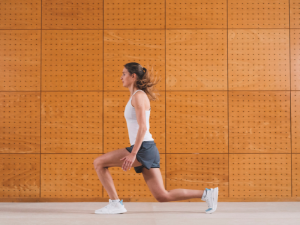
Reverse lunges are a variation of the traditional lunge exercise that emphasize the quadriceps, glutes, and hamstrings. Unlike forward lunges, reverse lunges place less stress on the knees and can help improve balance and coordination.
How To Do Reverse Lunges?
- Stand tall with feet hip-width apart.
- Take a step backward with one leg, lowering the back knee towards the ground.
- Lower the body until both knees are bent at a 90-degree angle.
- Press through the heel of the front foot to return to the starting position.
- Repeat on the other leg.
Execution Tips Enhanced:
- Keep the torso upright throughout the movement.
- Focus on maintaining balance by engaging the core muscles.
- Control the descent and ascent to prevent excessive strain on the knees.
Why It Works Explained:
Reverse lunges target the quadriceps, glutes, and hamstrings while placing less stress on the knees compared to forward lunges. By stepping backward, this exercise promotes better balance and stability while improving lower body strength and muscle coordination. Incorporating reverse lunges into a workout routine can help enhance overall lower body function and performance.
5. Back Squat:
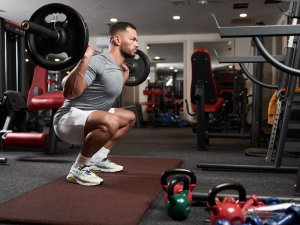
The back squat is a compound lower body exercise that primarily targets the quadriceps, hamstrings, glutes, and lower back muscles. It involves lifting a barbell placed on the upper back, providing a challenging full-body workout.
How To Do Back Squat?
- Stand with feet shoulder-width apart, toes slightly turned out.
- Place the barbell across the upper back, resting it on the trapezius muscles.
- Grip the barbell slightly wider than shoulder-width apart.
- Engage the core and unrack the barbell, stepping back to clear the rack.
- Lower the body by bending the knees and hips, keeping the chest up and the back straight.
- Descend until thighs are parallel to the ground or below, then drive through the heels to return to the starting position.
- Repeat.
Execution Tips Enhanced:
- Keep the chest up and the back straight throughout the movement.
- Ensure the knees track in line with the toes to prevent valgus collapse.
- Maintain tension in the core and upper back to support the spine.
Why It Works Explained:
The back squat is effective due to its ability to target multiple lower body muscle groups simultaneously while also engaging the core and upper back for stability. By utilizing heavy loads, the back squat promotes strength and muscle growth in the lower body, leading to improved performance in various functional movements and athletic endeavors.
6. Calf Raise:
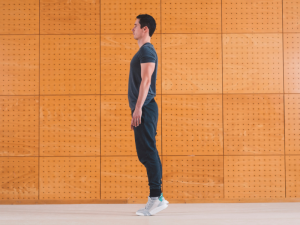
Calf raises primarily target the calf muscles (gastrocnemius and soleus), which are responsible for ankle flexion and propulsion during walking, running, and jumping. This exercise can be performed with bodyweight, dumbbells, or a calf raise machine.
How To Do Calf Raise?
- Stand tall with feet hip-width apart, toes pointing forward.
- Lift the heels off the ground by pushing through the balls of the feet.
- Hold the top position briefly, then lower the heels back down to the starting position.
- Repeat for the desired number of repetitions.
Execution Tips Enhanced:
- Focus on a controlled movement, avoiding jerking or bouncing.
- Squeeze the calf muscles at the top of the movement for maximum contraction.
- Gradually increase the range of motion by lowering the heels below the level of the toes.
Why It Works Explained:
Calf raises effectively target the calf muscles, promoting strength, endurance, and muscle hypertrophy. By performing calf raises regularly, individuals can improve ankle stability, reduce the risk of ankle injuries, and enhance overall lower body function.
Additionally, calf raises can complement other lower body exercises, such as squats and lunges, by strengthening the muscles involved in ankle movement and stabilization.
7. Hip Thrust:

Hip thrusts are effective exercises for targeting the glutes while also engaging the hamstrings and quadriceps. This exercise can be performed using bodyweight, a barbell, or resistance bands, making it suitable for individuals of all fitness levels.
How To Do Hip Thrust?
- Sit on the ground with your upper back resting against a bench or elevated surface.
- Roll a barbell over your hips and position it securely.
- Plant your feet flat on the ground, hip-width apart, and bend your knees.
- Brace your core and drive through your heels to lift your hips towards the ceiling.
- Squeeze your glutes at the top of the movement, then lower your hips back down with control.
- Repeat.
Execution Tips Enhanced:
- Ensure your upper back is firmly supported by the bench throughout the movement.
- Keep your chin tucked and your gaze forward to maintain proper alignment.
- Focus on fully extending your hips at the top of the movement to maximize glute activation.
Why It Works Explained:
Hip thrusts are highly effective for targeting the glutes, which are often underdeveloped in many individuals. By isolating and activating the glute muscles, hip thrusts can help improve strength, power, and overall lower body function.
Additionally, hip thrusts are beneficial for enhancing hip extension mechanics, which are essential for various activities such as walking, running, and jumping.
8. Step-Ups
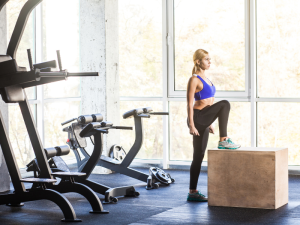
Step-ups are a versatile lower body exercise that can be performed almost anywhere with a stable surface. This exercise targets the quadriceps, hamstrings, and glutes while also improving balance and coordination.
How To Do Step-Ups?
- Stand in front of a sturdy bench or platform with your feet shoulder-width apart.
- Step onto the bench with one foot, ensuring it is flat and stable.
- Push through the heel of the elevated foot to lift your body onto the bench.
- Straighten your elevated leg and bring the opposite knee up until both legs are straight.
- Slowly lower yourself back down to the starting position, leading with the elevated foot.
- Repeat for the desired number of repetitions on one leg before switching to the other leg.
Execution Tips Enhanced:
- Maintain a controlled movement throughout, avoiding momentum.
- Keep your torso upright and engage your core for stability.
- Ensure the entire foot is planted on the bench to maximize balance and support.
Why It Works Explained:
Step-ups effectively target the quadriceps, hamstrings, and glutes while also engaging the calves and stabilizing muscles. By elevating one leg at a time, step-ups promote unilateral strength and balance, making them beneficial for correcting muscle imbalances and improving overall lower body stability.
9. Front Squat:
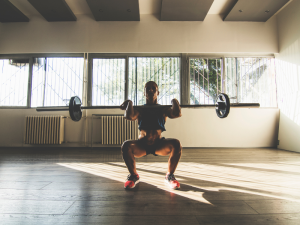
Front squats are a variation of the traditional squat exercise that place greater emphasis on the quadriceps, core, and upper back muscles. By positioning the barbell in front of the body, front squats require a more upright torso position, promoting greater knee flexion and targeting the quads.
How To Do Front Squat?
- Stand with feet shoulder-width apart and hold a barbell across the front of your shoulders, with elbows pointing forward.
- Engage your core and maintain an upright torso throughout the movement.
- Lower your body by bending your knees and hips, keeping your chest up and back straight.
- Descend until your thighs are parallel to the ground or slightly below.
- Press through your heels to return to the starting position.
- Repeat.
Execution Tips Enhanced:
- Keep the barbell positioned securely on the front of your shoulders throughout the movement.
- Maintain a strong grip on the barbell to prevent it from rolling forward.
- Focus on keeping your elbows up and chest lifted to maintain proper posture.
Why It Works Explained:
Front squats are highly effective for targeting the quadriceps, core, and upper back muscles due to the more upright torso position and greater knee flexion. By placing the barbell in front of the body, front squats shift the center of gravity forward, requiring increased core stability and upper back strength to maintain proper form.
Additionally, front squats can help improve mobility and flexibility in the ankles, hips, and thoracic spine, enhancing overall lower body function and performance.
10. Goblet Squat:
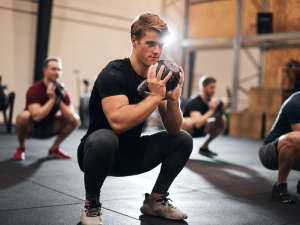
Goblet squats are a variation of the squat exercise that involves holding a kettlebell or dumbbell at chest level. This exercise is particularly effective for targeting the quadriceps, glutes, and core muscles while also promoting proper squat mechanics and posture.
How To Do Goblet Squat?
- Stand with feet shoulder-width apart and hold a kettlebell or dumbbell with both hands at chest level.
- Engage your core and maintain an upright torso throughout the movement.
- Lower your body by bending your knees and hips, keeping your chest up and back straight.
- Descend until your thighs are parallel to the ground or slightly below.
- Press through your heels to return to the starting position.
- Repeat.
Execution Tips Enhanced:
- Keep the weight close to your body and your elbows tucked in during the movement.
- Focus on maintaining proper squat mechanics, including tracking your knees over your toes and keeping your heels grounded.
- Engage your core and squeeze your glutes at the top of the movement to maximize muscle activation.
Why It Works Explained:
Goblet squats are highly effective for targeting the quadriceps, glutes, and core muscles while also promoting proper squat mechanics and posture. By holding the weight at chest level, goblet squats help improve upper body strength and stability while also increasing core activation.
Additionally, goblet squats are suitable for individuals of all fitness levels and can be easily modified by adjusting the weight and depth of the squat.
11. Leg Extension:
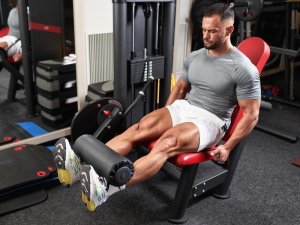
Leg extensions are isolation exercises that primarily target the quadriceps, providing a focused workout for strengthening and defining the front of the thighs. This exercise is commonly performed using a leg extension machine, making it accessible to individuals of various fitness levels.
How To Do Leg Extension?
- Sit on the leg extension machine with your back flat against the backrest and your legs positioned under the padded lever.
- Adjust the machine so that the back of your ankles are against the padded lever and your knees are aligned with the axis of rotation.
- Grasp the handles for stability and engage your core.
- Extend your legs upward by straightening your knees until your legs are fully extended.
- Hold the top position briefly, then lower the weight back down with control.
- Repeat.
Execution Tips Enhanced:
- Keep your back flat against the backrest throughout the movement to maintain proper spinal alignment.
- Control the movement and avoid using momentum to lift the weight.
- Focus on squeezing your quadriceps at the top of the movement to maximize muscle contraction.
Why It Works Explained:
Leg extensions are effective for isolating the quadriceps, promoting muscle growth and strength development in the front of the thighs. By targeting the quadriceps without engaging other muscle groups, leg extensions allow for precise muscle activation and can help address muscle imbalances.
Additionally, leg extensions can be beneficial for individuals recovering from knee injuries or looking to strengthen the quadriceps without placing excessive stress on the knees and lower back.
12. Kettlebell Swing:

The kettlebell swing is a dynamic exercise that targets the posterior chain, including the hamstrings, glutes, lower back, and core muscles. This explosive movement promotes power development, cardiovascular conditioning, and full-body strength.
How To Do Kettlebell Swing?
- Stand with feet shoulder-width apart and hold a kettlebell with both hands between your legs.
- Hinge at the hips and lower your torso while maintaining a flat back.
- Swing the kettlebell back between your legs, then explosively drive your hips forward to propel the kettlebell upward.
- Swing the kettlebell up to chest level by extending your hips and knees.
- Allow the kettlebell to swing back down between your legs and repeat the movement in a fluid motion.
Execution Tips Enhanced:
- Maintain a strong grip on the kettlebell throughout the movement to prevent it from slipping.
- Keep your core engaged and your back straight to protect the lower back.
- Focus on using the power generated from the hips to propel the kettlebell forward.
Why It Works Explained:
The kettlebell swing is highly effective for targeting the posterior chain muscles, including the hamstrings, glutes, and lower back. By performing explosive hip hinge movements, the kettlebell swing promotes power development and strength in the hip and posterior chain muscles.
Additionally, the dynamic nature of the exercise increases heart rate and calorie expenditure, making it a valuable addition to cardiovascular workouts.
13. Sissy Squats

Sissy squats are an advanced lower body exercise that primarily targets the quadriceps. This exercise requires balance and control as you lower your body into a deep squat position while keeping your torso upright.
How To Do Sissy Squats?
- Stand with your feet hip-width apart and grasp onto a stable surface for support, such as a squat rack or wall.
- Shift your weight onto your toes and slowly lower your body by bending your knees.
- Keep your torso upright as you descend, allowing your knees to move forward over your toes.
- Lower your body as far as comfortable or until your thighs are parallel to the ground.
- Push through your toes and extend your knees to return to the starting position.
- Repeat for the desired number of repetitions while maintaining control and balance.
Execution Tips Enhanced:
- Use a slow and controlled descent to maximize muscle engagement.
- Focus on maintaining proper form, keeping your knees aligned with your toes.
- Engage your core throughout the movement to stabilize your body and prevent excessive leaning.
Why It Works Explained:
Sissy squats target the quadriceps, with additional engagement of the glutes and calves. This exercise places a greater emphasis on knee extension, making it an effective isolation exercise for the quads. Sissy squats can help improve lower body strength and muscle definition, particularly in the quadriceps, while also enhancing knee stability and mobility.
14. Sumo Squat:
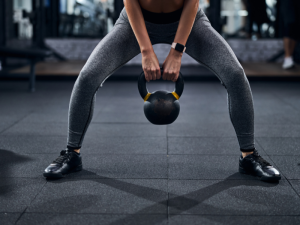
Sumo squats are a variation of the traditional squat exercise that targets the inner thighs (adductors) and glutes to a greater extent. The wide stance in sumo squats places emphasis on different muscle groups compared to regular squats, offering a unique challenge and variation to lower body training.
How To Do Sumo Squat?
- Stand with your feet wider than shoulder-width apart and toes pointed outward at a 45-degree angle.
- Hold a dumbbell or kettlebell with both hands in front of your body for added resistance, or keep your hands on your hips for bodyweight variation.
- Engage your core and maintain an upright torso.
- Lower your body by bending your knees and hips, keeping your chest up and back straight.
- Descend until your thighs are parallel to the ground or slightly below.
- Press through your heels to return to the starting position.
- Repeat.
Execution Tips Enhanced:
- Ensure your knees track in line with your toes throughout the movement to prevent valgus collapse.
- Keep your chest lifted and shoulders pulled back to maintain proper posture.
- Focus on pushing your knees outward to engage the adductor muscles effectively.
Why It Works Explained:
Sumo squats target the inner thighs (adductors) and glutes more intensely due to the wider stance, providing a different stimulus to the lower body muscles compared to traditional squats. By emphasizing a wider foot placement and outward toe positioning, sumo squats activate the adductor muscles to a greater extent, improving lower body strength and stability.
Additionally, sumo squats can help improve hip mobility and flexibility, making them beneficial for individuals looking to enhance overall lower body function and performance.
15. Staggered Stance Squat:

Staggered stance squats, also known as split squats, are unilateral exercises that target each leg independently, helping to correct muscle imbalances and improve lower body strength and stability. This exercise also requires coordination and balance, making it a valuable addition to any lower body training program.
How To Do Staggered Stance Squat?
- Stand with one foot positioned slightly in front of the other, maintaining a staggered stance.
- Hold a dumbbell or kettlebell in each hand for added resistance, or perform the exercise with bodyweight only.
- Engage your core and maintain an upright torso throughout the movement.
- Lower your body by bending both knees, keeping your chest up and back straight.
- Descend until your front thigh is parallel to the ground or slightly below.
- Press through the heel of your front foot to return to the starting position.
- Repeat the movement on the other leg.
Execution Tips Enhanced:
- Keep your front knee aligned with your ankle to prevent it from extending past your toes.
- Maintain tension in your core and glutes to stabilize your body during the movement.
- Focus on lowering your body with control and pushing through your front heel to maximize muscle activation.
Why It Works Explained:
Staggered stance squats target each leg independently, helping to correct muscle imbalances and improve unilateral lower body strength and stability. By focusing on one leg at a time, staggered stance squats allow for greater muscle activation and recruitment, leading to improved overall lower body function and performance.
Additionally, this exercise can help improve balance and coordination, making it beneficial for athletes and individuals participating in sports or activities that require single-leg stability and control.
Conclusion: Key Takeaways and Final Thoughts
In conclusion, incorporating lower body push exercises into your workout routine offers numerous benefits for overall physical health and well-being. These exercises target major muscle groups in the legs and hips, promoting strength, stability, and functional movement patterns.
You can enhance their strength, balance, and coordination while reducing the risk of injuries by engaging in compound movements that mimic everyday activities and emphasizing proper form.
Key takeaways from this exploration of lower body push exercises include the importance of muscle engagement, functional movement patterns, and compound movements for efficient workouts and calorie expenditure.
Additionally, the benefits extend beyond physical fitness to include improved joint health, metabolic benefits, enhanced athletic performance, and ultimately, a higher quality of life.
Incorporating a variety of lower body push exercises, such as squats, lunges, and calf raises, into your fitness routine can help you achieve optimal results and maintain a healthy, active lifestyle. Whether you’re a beginner or an experienced athlete, focusing on lower body strength training can have a profound impact on your overall fitness journey.
Key Points
- Lower body push exercises target muscles in the legs and hips, emphasizing movements where force is exerted away from the body using the legs and feet.
- These exercises engage major muscle groups including the quadriceps, hamstrings, glutes, and calves, promoting strength and muscle development in the lower body.
- Lower body push exercises mimic everyday movements like walking, running, and climbing stairs, improving functional fitness and mobility for daily activities.
- Many lower body push exercises involve compound movements, engaging multiple muscle groups simultaneously for efficient workouts and greater calorie expenditure.
- Lower body push exercises play a crucial role in building strength, enhancing stability, and improving athletic performance.
- Regular engagement of major lower body muscle groups through resistance training promotes strength, power, and muscle definition.
- Training movement patterns like walking and standing up from a seated position with resistance improves daily activity performance.
- Lower body push exercises enhance overall balance, stability, and coordination, reducing the risk of falls and injuries, especially with aging.
- Engaging large muscle groups elicits a significant metabolic response, aiding in calorie burning and weight management.
- Proper execution of lower body push exercises improves joint stability, flexibility, and mobility, reducing the risk of common injuries.
- Strengthening lower body muscles enhances performance in various sports and activities like jumping, sprinting, and change of direction.
- By improving lower body strength and fitness, these exercises promote independence, an active lifestyle, and overall well-being as individuals age.
FAQs
Can lower body push exercises improve athletic performance?
Absolutely. They enhance power, speed, and endurance, directly translating to improved performance in virtually any sport.
How do I avoid injury while performing lower body exercises?
Focus on form over weight, progress gradually, and listen to your body. When in doubt, seek guidance from a fitness professional.
What muscle groups does lower body push exercises work?
Lower body push exercises primarily target the muscles of the lower body, including the quadriceps, hamstrings, glutes, and calves. These exercises involve movements where force is exerted away from the body using the legs and feet, such as squatting, lunging, and calf raising.
Additionally, lower body push exercises often engage other muscle groups, including the core and upper body, to provide stability and support during the movements. Overall, lower body push exercises are effective for building strength, improving stability, and enhancing functional movement patterns in the lower body.
How long should a push legs workout be?
A push legs workout typically lasts between 60 to 90 minutes, including warm-up, main exercises, accessory work, and cool-down. However, the duration may vary based on individual fitness levels, training goals, and exercise intensity. It’s essential to listen to your body and adjust the duration accordingly to ensure adequate rest and recovery.
Is push legs too much for a beginner?
Push legs workouts can be intense for beginners if not properly structured. It’s essential for beginners to start with simpler exercises, focus on proper form, and gradually increase intensity and volume over time.
Beginners may benefit from starting with full-body or upper/lower split routines before transitioning to push legs splits to build a solid foundation of strength and conditioning. Consulting with a fitness professional or personal trainer can help beginners tailor their workouts to their fitness levels and goals while minimizing the risk of injury.

ABOUT THE AUTHOR
Follow Valen Steven for a dose of fitness enthusiasm, evidence-based advice, and a roadmap to achieving your health and wellness goals.
Subscribe to our Newsletter
Dive into a world of fitness and wellness with our exclusive newsletter! Sign up now and receive weekly power-packs of fitness wisdom

